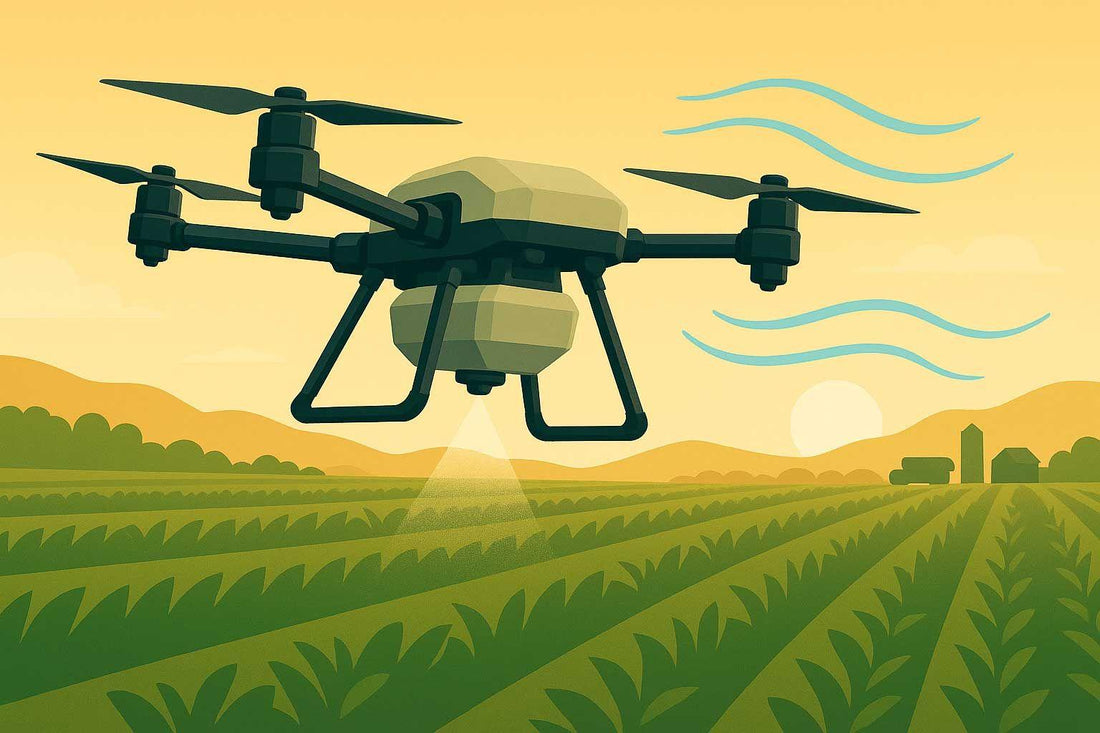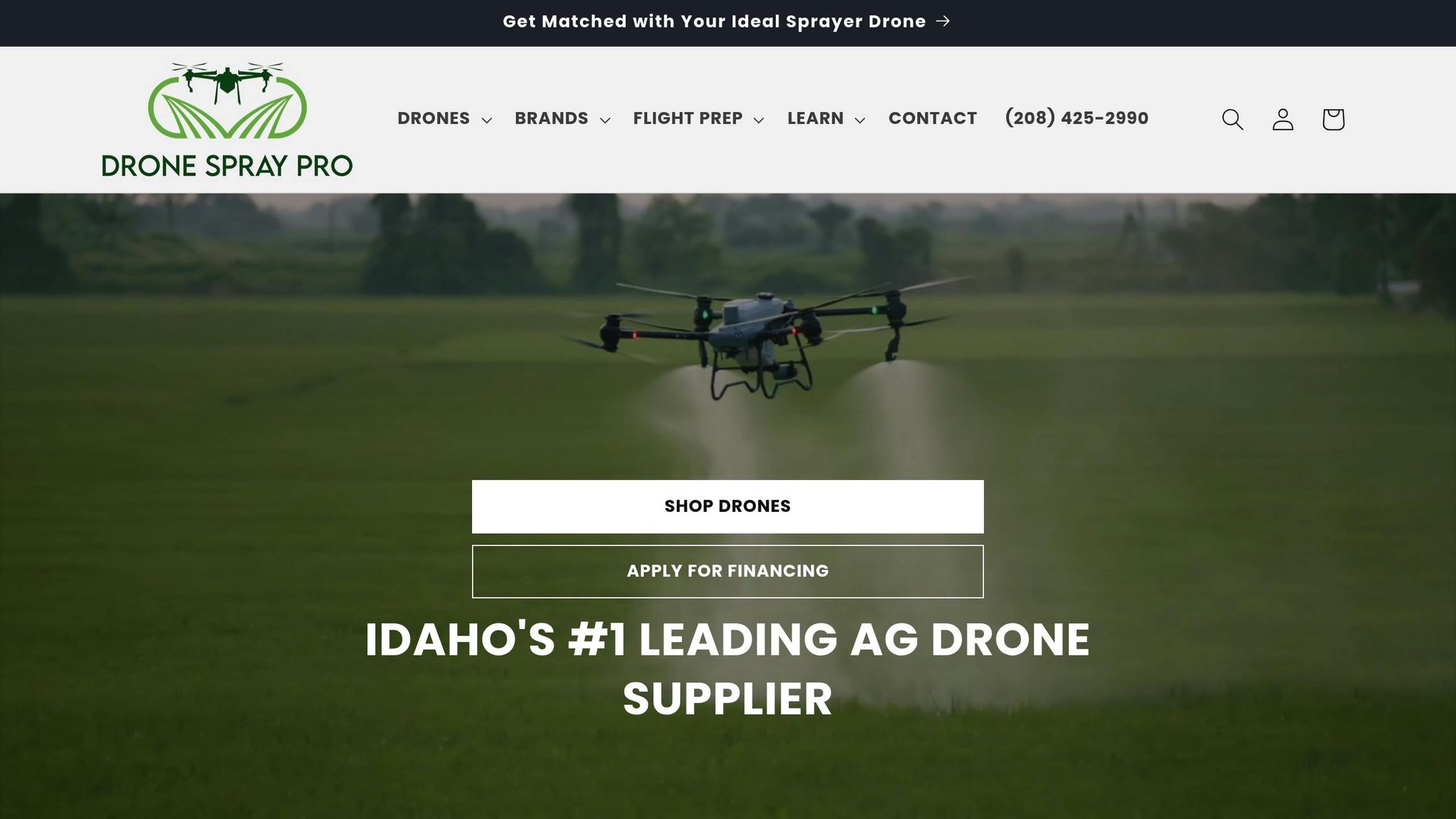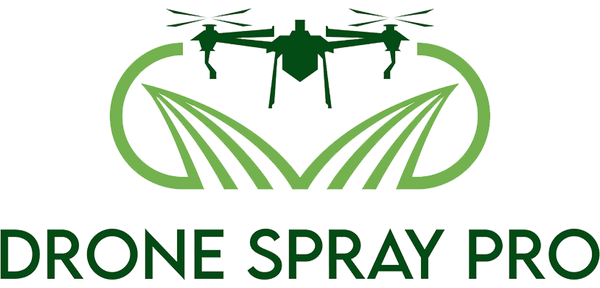
How Wind Affects Spray Drone Efficiency
Share
Wind is a major challenge for spray drones. It impacts flight stability, spray accuracy, and battery life. Here’s what you need to know:
- Ideal Wind Speeds: Best results occur when wind speeds are between 3–8 mph. Speeds over 8 mph increase chemical drift, while speeds under 3 mph can cause uneven spray coverage.
- Spray Drift Risks: Wind over 8 mph can increase drift by 700% at 90 feet downwind, wasting chemicals and risking environmental contamination.
- Battery Drain: Strong winds force drones to use more power, reducing flight time and efficiency.
- Safe Limits: Professional drones can handle winds up to 20–25 mph, but performance drops at around 75% of their wind capacity.
Quick Tips to Manage Wind:
- Spray during early mornings or late afternoons when wind is calmer (2–10 mph).
- Use coarser droplets and adjust nozzle settings to reduce drift.
- Plan flights based on real-time wind data and avoid gusty conditions.
- Fly at lower altitudes to minimize wind effects when safe.
Understanding and managing wind conditions can save costs, reduce waste, and improve spray accuracy. Keep reading for detailed strategies and equipment recommendations.
Spray Drone High Wind Test #shorts #agrast40 #drone #djiagriculture #wind #farming #spraydrone
Wind Effects on Spray Patterns and Coverage
Wind can throw a wrench into carefully calibrated spray patterns, leading to uneven coverage and wasted chemicals. These disruptions highlight how wind contributes to spray drift and alters droplet behavior.
Spray Drift and Chemical Loss
Spray drift happens when wind carries pesticide droplets away from their intended target, causing financial losses and potential damage to the environment. For instance, doubling wind speed can increase drift by as much as 700% at just 90 feet downwind. This staggering figure underscores why it’s critical to monitor wind speeds, especially since winds above 8 mph drastically increase drift risks.
"Spray drift, defined as 'the quantity of plant protection product that is carried out of the sprayed (treated) area by the action of air currents during the application process' (ISO, 2005) can be one of the most important (or main) factors affecting the risk of environmental pollution with pesticides, and therefore, there is a strong need for drift measurement methods."
Even a small change in wind speed - just 1 m/s - can shift drift by 0.94% per meter, making precise wind direction measurements vital. To predict drift patterns accurately, professional operators often calculate wind direction in degrees relative to their sampling line.
Using low-drift equipment can cut spray drift by 38%, demonstrating the importance of combining the right tools with careful wind management.
Changes to Droplet Size and Coverage Consistency
Wind doesn’t just carry droplets away - it also affects their size and how evenly they’re distributed. For example, droplets smaller than 50 microns can evaporate before they even reach their target, making them especially prone to drifting off course.
The size of the droplets plays a huge role in how wind impacts them. Research shows that with a 10 mph wind and 60% relative humidity, 100-micron droplets drift about 18 times farther than 200-micron droplets. This makes nozzle selection and droplet size control essential when dealing with windy conditions.
Wind speed also directly influences how chemicals are deposited. Higher wind speeds can cause chemicals to concentrate closer to the drone while reducing coverage farther away. At wind speeds of 5 m/s (roughly 11 mph), treatment efficiency can drop by 70% compared to calm conditions. This forces operators to either deal with insufficient coverage or make extra passes, which drives up costs.
Additionally, strong winds can deflect spray jets, creating small gaps in coverage that might not be immediately noticeable. These gaps can be a serious issue when uniform chemical application is necessary to combat pests or diseases effectively.
Wind Impact on Drone Flight and Energy Use
How wind affects both spray patterns and flight performance plays a big role in drone operations. Beyond influencing accuracy, wind increases energy demands, which shortens flight times and strains overall efficiency.
Higher Energy Use and Shorter Flight Time
Flying in windy conditions drains drone batteries much faster. Headwinds require more power to maintain speed, while crosswinds force constant adjustments to stay on course. Both scenarios lead to quicker battery depletion.
"Drones' batteries drain quickly when flying against strong winds. More energy exerted to combat winds means faster draining. Flying in wind means a shorter mandated flight time for drones."
– dronegenuity
Extreme temperatures make things worse. Cold weather can reduce battery efficiency by as much as 40%, while hot conditions risk overheating the system. Combine this with the extra effort motors put in to counteract wind, and you’re left with shorter flight times and reduced coverage. This means operators need to manage more batteries and plan for frequent landings, making it essential to stay within safe wind speed limits.
Safe Wind Speed Limits for Spray Drones
Establishing clear wind speed limits is critical for safe and efficient drone operations. Consumer drones typically handle wind speeds of 10–15 mph, while professional models can manage up to 20–25 mph. However, performance starts to deteriorate when wind speeds reach about 75% of these limits.
For instance, a drone rated for 25 mph winds may experience significant efficiency and accuracy issues around 18–19 mph. At this point, battery consumption spikes, and spray precision becomes unreliable.
Sudden gusts add another layer of difficulty. These can disrupt altitude control and lead to uneven spray patterns. Even if average wind speeds are within acceptable ranges, gusts exceeding 70% of a drone’s rated capacity can create unsafe flying conditions.
"As the Pilot in Command (PIC) you are responsible for your equipment, flight operations and ensuring your drone operates within its safe limits. Always follow the recommended guidelines in your user manual and never exceed the recommended limits for your drone."
– Craig Holland
To mitigate these challenges, professional operators often plan their missions based on wind forecasts. By scheduling spray activities during calmer periods, they can optimize battery life and ensure consistent spray coverage.
Methods to Reduce Wind Problems
Tackling wind challenges is essential for improving the efficiency of drone spraying. By carefully considering the timing of operations, conducting thorough pre-flight wind assessments, and fine-tuning equipment, drone operators can achieve better results even in less-than-ideal conditions.
Best Times for Spraying
The early morning and late afternoon are the most favorable times for drone spraying. During these hours, wind speeds typically range between 2–10 mph, allowing for more consistent spray patterns and coverage.
Morning hours, particularly from dawn to 10 AM, often provide the calmest conditions. Cooler temperatures during this time help minimize thermal updrafts, which can lead to erratic wind behavior. Similarly, late afternoon - roughly from 4 PM until dusk - offers increased stability as the atmosphere cools down.
Midday spraying should be avoided whenever possible. Higher temperatures during this period not only amplify wind activity but can also degrade chemicals and strain drone batteries, increasing the likelihood of overheating.
"If strong winds are common in the afternoon, scheduling flights for the early morning might provide more stable conditions." - Terra Drone Agri
Wind Planning Before Flight
Effective pre-flight planning begins with reliable weather monitoring. Many drone flight planning tools now integrate weather APIs that provide highly accurate hourly forecasts, enabling operators to schedule flights during optimal conditions.
Real-time wind monitoring is especially important when weather changes quickly. On-farm weather stations can deliver precise, up-to-the-minute wind data, allowing for better decision-making.
Flight paths should be strategically planned to minimize wind resistance. For instance, flying perpendicular to the wind direction first can conserve battery life by leveraging crosswinds, while avoiding prolonged headwinds reduces energy consumption.
"The difference between successful data collection and wasted flight time often comes down to your weather preparedness strategy." - FarmstandApp
Altitude adjustments are another crucial consideration. Since wind speeds tend to increase with height, flying at lower altitudes - when it’s safe and practical - can improve control. However, operators must balance this with the need for adequate coverage and obstacle clearance. Spray settings should also be adjusted to counteract wind drift effectively.
Changing Spray Settings
The choice of nozzle plays a significant role in managing wind-induced spray drift. Nozzles that produce medium to coarser droplets, such as AIXR or AirMix nozzles, are better suited for windy conditions. In contrast, XR flat-fan nozzles are best reserved for calm conditions with wind speeds below 4–5 mph.
Droplet sizes between 250 and 320 micrometers strike a good balance, as they are less prone to wind drift while still ensuring thorough coverage. Adjusting nozzle pressure to produce larger droplets and reducing drone speed can further mitigate drift. Additionally, lowering flight altitude - when feasible - helps reduce the impact of higher wind speeds at greater heights.
Incorporating drift-reducing adjuvants (DRAs) into spray mixtures can also improve coverage and minimize drift. These additives help droplets stay on course and adhere more effectively to the target surfaces.
If wind speeds exceed 10 mph, it’s best to postpone spraying operations. At this level, even with adjustments, maintaining precise spray patterns becomes difficult, potentially compromising both the effectiveness of the application and overall safety.
sbb-itb-3b7eef7
Equipment Solutions and Best Practices
Selecting the right equipment and adhering to proven techniques can make all the difference when spraying in windy conditions. Modern agricultural drones are equipped with features designed to handle tough weather, and proper training ensures operators can get the most out of their investment.
Advanced Drones with Wind-Resistant Features
Professional-grade spray drones can operate in winds of 20–25 mph, far surpassing consumer models that manage only 10–15 mph.
The DJI Agras series stands out with its advanced stabilization systems, dynamic yaw control, and automatic wind compensation, which help maintain precise flight paths even during gusts. Its reinforced carbon-fiber frames and low-profile designs minimize wind resistance while ensuring durability.
Talos T60X drones utilize CFD modeling to optimize propeller efficiency, reducing drag by up to 30%. This design is especially useful when flying against headwinds, which can otherwise drain battery life quickly.
As drone technology advances, newer models are being developed to handle winds up to 35 mph. These drones feature improved stabilization systems, terrain sensors to maintain consistent flight height over uneven ground, and weather-resistant components to handle humidity and temperature changes.
XAG and ABZ Innovation models offer modular payload options, allowing operators to adjust the drone’s weight for better stability in moderate winds. This flexibility ensures that operators can continue working even when conditions are less than ideal.
Real Time Kinematics (RTK) technology is another game-changer, offering centimeter-level accuracy in positioning - a critical feature when wind impacts flight paths. However, even with advanced hardware, operator skill remains key to achieving optimal performance in challenging conditions.
Training and Licensing Requirements
Proper training and FAA certification are essential for safely operating drones, especially in windy conditions. The FAA Part 107 certification covers crucial topics like airspace regulations, weather analysis, and operational limitations that directly affect spray drone performance.
Professional training programs go further by teaching pilots how to evaluate weather conditions, interpret wind patterns at various altitudes, and identify when it’s unsafe to fly. These programs also cover emergency procedures to ensure safe landings in unexpected situations.
For those looking to expand their expertise, advanced certifications in areas like drone surveying, thermal imaging, or mapping can provide valuable insights into managing the effects of wind on spray operations. Equally important is selecting equipment that suits the specific conditions of the operator's region.
Custom Solutions from Drone Spray Pro

Drone Spray Pro specializes in solutions tailored to Idaho’s agricultural needs, where wind patterns vary widely across different terrains and elevations. Their pre-configured drone packages are designed to handle these local challenges while maximizing spray efficiency.
Their offerings include trusted models like the DJI Agras, Talos T60X, XAG, and ABZ Innovation drones, all chosen for their wind-resistant features and reliability in agricultural settings. These packages come equipped with high-capacity batteries, specialized chargers, and RTK dongles for precise positioning.
RTK dongles are particularly valuable in windy conditions, providing real-time corrections to maintain consistent spray patterns even when gusts push the drone off course. In Idaho’s unpredictable winds, these tools greatly enhance operational reliability.
Drone Spray Pro also supports operators through the FAA certification process, helping them navigate regulatory requirements and practical considerations for flying in challenging conditions. Their training programs focus on real-world applications, such as adjusting flight settings based on local wind patterns.
The company offers ongoing technical support, advising on payload configurations, integrating flight planning software with weather APIs, and maintaining drones for peak performance in tough environments.
Battery technology has also seen significant improvements. Some lithium-polymer batteries now maintain 85% efficiency in temperatures ranging from 20°F to 110°F. Drone Spray Pro ensures their packages include batteries and charging systems optimized for Idaho’s temperature swings and the extra power demands of windy flights.
Their expertise recognizes a critical factor: flight stability drops noticeably at 75% of a drone’s maximum wind tolerance. This can impact both spray quality and battery efficiency. By providing well-matched equipment and expert guidance, Drone Spray Pro helps operators extend their effective working hours while maintaining safety and performance.
Conclusion: Managing Wind Impact on Spray Drones
Effectively managing wind during drone spraying requires a mix of planning, advanced tools, and skilled operators. Keeping operations within 75% of a drone's maximum wind capacity helps ensure stable flight and precise spraying, reducing chemical drift and waste.
Timing plays a crucial role. Early mornings or late afternoons, when wind speeds are typically between 2-10 mph, are ideal for spray operations. These calmer periods align perfectly with the use of equipment designed to handle wind challenges.
Choosing the right equipment also makes a big difference. High-performance drones like the DJI Agras series, Talos T60X, XAG, and ABZ Innovation models come equipped with wind-resistant features that deliver reliable results even in less-than-ideal conditions.
"Just knowing how to fly a drone doesn't get you very far. There's a lot more you need to learn about pesticides and pesticide application." - Steve Li, associate professor and Extension specialist, crop, soil and environmental sciences, Auburn University
As Steve Li highlights, technical expertise is critical. FAA Part 107 certification is just the starting point. Operators also need specialized agricultural training to assess wind patterns, fine-tune spray settings, and identify unsafe conditions.
For operators in challenging areas, like Idaho's diverse landscapes, working with experts such as Drone Spray Pro can make all the difference. These partnerships provide access to drone packages tailored to local conditions, ensuring efficiency even when wind increases flight times and drains battery power more quickly.
By understanding wind effects and applying mitigation strategies, operators can maintain consistent spray coverage. Techniques like flying at proper altitudes, programming thoughtful flight paths, and continuously monitoring conditions during operations create a solid foundation for success.
While wind is a constant factor in drone spraying, it doesn’t have to disrupt your workflow. With the strategies discussed here, you can confidently manage wind challenges and maintain productive spraying schedules, even in tougher conditions.
FAQs
How can I adjust spray drone settings to reduce wind impact on coverage?
To reduce the impact of wind on spray coverage, there are a few practical steps you can take. Start by keeping a close eye on wind conditions and avoid operating your drone when wind speeds exceed 10 mph. Strong winds can lead to significant drift and uneven spray distribution. Another helpful tip is to lower the drone's flight altitude, which can cut down on droplet drift and lead to more accurate spraying.
Using nozzles specifically designed for aerial spraying is another smart move. By adjusting droplet sizes, you can strike the right balance between effective coverage and minimizing drift. Additionally, drones equipped with real-time monitoring systems can make a big difference. These systems let you make quick adjustments mid-flight, ensuring consistent performance even when the wind picks up. Implementing these techniques can help you achieve more precise and efficient spraying, even in less-than-ideal weather conditions.
How does wind speed affect spray drone performance and battery life, and what can operators do to reduce its impact?
How Wind Speed Affects Spray Drone Performance
Wind speed plays a big role in how well spray drones perform and how long their batteries last. When winds are strong, drones have to work harder to stay steady and fight turbulence, which drains their batteries faster. Most professional agricultural drones can handle winds up to 20–25 mph, but their efficiency starts to drop as wind speeds get closer to those limits.
To minimize the effects of wind, operators can follow a few smart strategies. Flying at lower altitudes can help avoid the stronger winds that are usually present higher up. Another tip is to plan flight paths carefully - start flying perpendicular to the wind and then move parallel to it. This approach can help make energy use more efficient. Lastly, keeping a close eye on wind conditions and delaying flights when gusts are too strong ensures safer and more effective operations.
How do advanced spray drones handle windy conditions effectively?
Advanced spray drones come packed with modern features that allow them to handle windy conditions with ease. For instance, they often feature dual atomized nozzles, which can adjust spray patterns and droplet sizes. This helps minimize drift and ensures the spray reaches its target accurately. Another standout feature is terrain-following radar, which adapts to changes in elevation, keeping spray coverage consistent - even when wind speeds fluctuate.
On top of that, these drones typically rely on GPS-based route planning and dynamic flight path adjustments to counteract wind direction and maintain stability. These technologies not only boost precision but also enhance operational safety, making these drones a dependable option for agricultural tasks, even in less-than-ideal weather.
